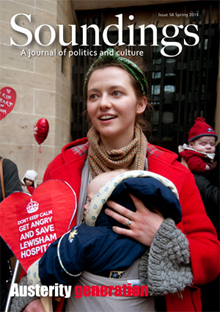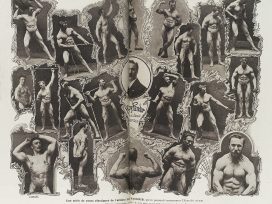In 2013, a time when capitalism ruled the world, the former British Library precinct within the British Museum – where Karl Marx once spent many productive years calculating this outcome – hosted an exhibition of the earliest evidence of human imagination. Ice Age Art assembled a cornucopia of figurative objets d’art created up to 40,000 years ago (or more), depicting humans and the other animals with whom they shared space.
The audience was greeted by voluptuous fecundity: ripe, round female figures, with reindeers in flight, fish, birds, mammoths, lions, flutes, fish hooks, needles, and an occasional male. I trust that Marx would have been awed.

T.J. Clark, a distinguished art critic, was not so much awed as affronted by the sheer, surprising woman-ness of this universe. Writing in the London Review of Books he catches himself out for assuming that the image-makers were men, and concedes the prevailing inference that it is “more likely” that the creators were women. He speculates on pregnancy not as the moment when women’s bodies are home to another, but as a kind of alienation, “a body becoming other to itself.” It is also “fearful, astonishing, ominous”, he mutters, and the figurines “fat, fat, fat”. He acknowledges what many of his readers, no doubt, will have already guessed: “I know I am lost.” No willies, few weapons, no bodies whose raison d’être is to be desired.
But during my three visits there, I sensed not estrangement but wonder, whispered joy, the intoxicated rustle of spectators fascinated by imagination that appeared to be – as the children’s illustrator Maurice Sendak said of himself before he died in 2012 – “in love with the world”. But who knows? Who knows what or how they were thinking, these Ice Age humans? Who knows what they intended their audience to see and feel, and what they wanted their creations to mean?
That said, this art does seems to enunciate a challenge to an Enlightenment notion – recently reiterated by Steven Pinker in his grand theoretical work of 2012, The Better Angels of Our Nature: Why Violence Has Declined – that our ancestors were brutal and brutalized (and blokes), making their way in the world savagely; that they are strangers to us because we, their refined descendents, are uniquely rational, prosperous, democratic and pacific.
From three (yes, three) corpses of men who lived a mere 5000 years ago, Pinker is able to deduce the existence of general homicidal tendencies that, through evolution and enlightenment, have now been tamed. I would be much more cautious about inferring anything so definite about life in the era of Ice Age, whether from their art or indeed their cadavers. We surely cannot claim that it was either peaceful or violent: we don’t know. But whatever else it is, Ice Age art is a forensic riposte to fantasies of liberal, capitalist modernity as progress to prosperity, democracy, peace and love.
Ice Age imagination reminds us that war and peace have histories, they are social practices; that violence between humans is not universal, eternal, inevitable and valorized. And what’s more, violence and crime are specialisms – almost exclusively associated with specific cultures that create masculinity-as-domination. Feminism insists that violence is not biological or hormonal, but social; that crime, violence and war are productive of power; that they are – as theorists in second-wave feminism ventured – “resources” in the “achievement” or “doing” or “performance” of masculinities.
Drilled to kill, doomed to die: mastery and martyrdom is the heart-breaking dialectic of the manufacture of militarized, violent masculinity. Pinker’s evolutionism cannot help us understand either the astounding, industrialized violence of the twentieth century or the contagious armed conflicts of the twenty-first.
In the post-cold-war era the world is not at peace, it is plagued by what Mary Kaldor calls “new wars” – and in this context gender hierarchy and oppression is renewed. The making and maintaining of militarized masculinities is vital to these new modes of armed conflict that are proliferating across the flexible frontiers of globalized capitalism, between and within states. Violence is franchised out to auxiliary militias, security corporations and freelancing warlords: gangs, guerrillas, police, death squads and vigilantes prosper; their networks of criminal free trade and spatial domination overpower the best efforts of ‘new democracies’ from Soweto to Sao Paulo. As Kaldor insists, rape and pillage are the modus operandi of ‘new wars’: they should not be seen as collateral damage. Neoliberal capitalism radiates violence. The richest society on the planet is armed. And it invests in one of the largest prison systems in the world. Violence circulates between state and citizen. In 2011, the US locked up one in every 107 people, and one in 50 were on probation. Half a million people are “correctional” officers, not to mention the many thousands of others who service and supply the system of incarceration.
Violence is not unthinking, visceral, primitive; it is produced by, and is productive of, power and control over land, riches and people. Violent hypermasculinities and concomitant gender polarization are, therefore, not residual: they are remade in civil society and in state apparatuses. Indeed the violence that neoliberal capital and its accomplices generate is an integral part of its evolving gender settlement – which I call neo-patriarchy.
The end of the equality paradigm
In spite of this increased violence, and the inequality that is inherent in neoliberalism, in the last quarter of the twentieth century the world’s institutions reached a consensus: they joined together in hailing the goal of gender equality. Ironically, this was at the very moment when we were witnessing the limits, the exhaustion, of the equality paradigm.
The notion of equal opportunity was, in any case, incapable of withstanding the structures of gender: the sexual division of labour, and violence as a resource in the making and doing of masculinity. But with the collapse of the postwar consensus on welfare states and the mixed economy, the equality paradigm is now being defeated by the counter-revolutionary, neoliberal priorities of the world’s financial institutions.
They preach equal opportunity, but in practice produce a “regressive modernization” that reshapes but continues the patriarchal division of labour, and of traditional masculinities and femininities.
So, beware the liberation language of global capitalism: it rules the world, and it deploys the language of freedom, choice and competition to oust solidarity, co operative creativity and equality. After the deluge of state communisms, the world is quivering with resistance but struggles to find new ideological and institutional forms for those great values of solidarity, co-operation, creativity and equality – values that are crucial for gender equality. In this moment of capitalism’s hegemony – its apparent inevitability, invincibility and normality – the language of the marketplace appears not only to govern the economy, but life itself.
It is a lie, of course. Capitalism does not do life. And that lie is never more exposed in the twenty-first century than when we bring to it the light of gender and the unsaid – the silences and secrets that are knotted in the articulation of capitalism and patriarchy.
“Woman” as commodity, as carer, as producer and reproducer (though rarely hailed, it appears, as taxpayer and never as citizen) is positioned anew as Other; the sovereignty of ideologies of masculinity is simultaneously rattled and reinstated. Gender, uniquely, exposes the limits of this articulation, its contradictions and – most important – its unsustainability. The old sexual contract is recognized as unsustainable but retained in modernized form. Neoliberal neo-patriarchy is the new articulation of male domination.
But gender, uniquely, exposes the limits of neoliberal hegemony, its contradictions and – most important – its unsustainability. Though neoliberal neopatriarchy is hegemonic, it is an unstable site of torrid angst, complaint and trouble – and radical alternatives. As Leonard Cohen saw:
There is a crack in everything
There’s a crack in everything
That’s how the light gets in (Anthem).
Although gender remains an often invisible, or at best marginal, theme in radical and party political discourses, it takes us to the fissures and fault-lines, to the unsustainabilities, of the new, global capitalist settlement. For gender, like nature, is omni-relevant: it is everywhere, in everything. The new global settlement is nothing if not a new sexual settlement. Global capitalism works with patriarchal principles, institutions, cultures and psyches. So, our liberation from this tragedy is inconceivable – it is, literally, unthinkable – without feminism.
Before returning to the theme of patriarchy’s violence, I want to turn now to talk about the continuing sexual division of labour within Britain. I then look at the ways in which the global reach of neoliberalism is undermining equality and reconfiguring gender in Asia and South America.
Exploitation and the gendered division of labour
A key problem for the concepts of equal pay and equal opportunity in both socialist and capitalist societies is that they never envisaged the transformation of men and masculinities. (And understanding this – including understanding that this was an effect of the historical defeat of women in the nineteenth century – helps make sense of the gender inequality problem as not a problem of evolution or choice (women choosing to have babies!) but of politics).
Historically, labourism participated in the settlement that created men as breadwinners, cared for by the sequestered and unpaid domestic labour of women. That division of labour was cemented in the 1880s by the compromise between capital and labour that was expressed in the concept of men’s wages as the “family wage”. And that principle prevailed in collective bargaining for almost a century. Of course, there have always been women and men for whom equality was the heroic ethic of their union or their party. But that principle was not the practice, either in wage bargaining or, later, in incomes policies.
In the 1970s and 1980s, the impact of women’s liberation and other movements on trade unions and labourism began the process of transforming what could be perceived of as a men’s movement (a form of class politics engaged at the expense of anyone who was not male and white). For a couple of decades, the impact of European directives and of the women’s liberation movement was palpable in trade unions; and the effects of a new politics could be seen in the rise of the radical municipalism that was promoted by a new generation of metropolitan labourism; and, a little later, it was evident in the great wave of devolution.
Women’s political representation improved during this period, though Britain’s mother of Parliaments, the House of Commons, ranks only 65th in the world league: despite more women than ever having been elected, they still constitute a meagre 23 per cent in the unreconstructed Commons. But in the devolved institutions women’s representation has increased more substantially: in the Welsh Assembly it is 40 per cent, and in the Scottish Parliament 35 per cent.
The notion of equal opportunities was always skewed by the domestic division of labour: women’s relative poverty always provided the alibi for men’s relative absence from the unpaid labours of love and care. But there was huge change in the last quarter of the twentieth century. However, these new movements toward equality were scarcely seeded in Britain before, at the end of the twentieth century, equalities legislation – most of it barely a quarter of a century old – began to be routinely and institutionally disparaged and sabotaged.
And by the 2000s progress on equal pay had stalled. Four decades of activism had dragged women’s relative pay upwards, but only up to a point. In the twenty first century, despite some heroic equal pay activism in the tribunals, the disabling of unions in the private sector, the consolidation of gendered segregation and divisions of labour, resistance to any reduction in men’s “working day” by companies, governments and men generally – all these contributed to the renewal, rather than the decline, of inequalities.
In the 1970s the gender contradictions of the labour movement had been dramatized by a number of events. At the beginning of the decade, following the recommendations of the Prices and Incomes Board, government and unions agreed to the introduction of another patriarchal perk in the public sector: the bonus, which was mainly available to men. This bonus system became a vector of secrecy and sexism for the following thirty years. Meanwhile, as if in a parallel universe, the 1969 Equal Pay Act was to be implemented. Then in 1974-75 there was a major battle over the Social Contract between the Labour government and trade unions, many elements of which would potentially redistribute resources to women. In exchange for restraints on industrial action, a flat rate pay rise was proposed – that is an equal £6 pay rise for all (£3 for part-timers); this was designed to boost the relative earnings of the low paid – the majority of whom were women – in a period of inflation-led wage increases that were increasing the pay gap. And the Social Contract also included a provision – again especially important to women – for the enhancement of the social wage, particularly through investment in education and health. But multiple pressures yielded an ugly tangle between egalitarian tactics and patriarchal hierarchies. Under the unbearable weight of the oil crisis, and prime minister Jim Callaghan’s endorsement of monetarism, the Social Contract collapsed. “Free collective bargaining” was restored, and with it “time honoured and, therefore, conservative conventions”. This was the last time that an egalitarian pay policy, linked to the expansion of the social wage and the redistribution of social power, was contemplated in Britain.
The battles of 1970s Britain – and what followed after the left’s defeat – represent a case study of the effects of a shrinking down of the socialist project to the individual wage (rather men’s wages), alongside the valorization of “free collective bargaining” as the detonator of capitalism.
By the time that Labour returned to government in 1997, its social contract, insofar as there was one, operated informally between New Labour and the City: in return for relative autonomy for the financial industry and the City, Labour’s social programme was to be funded from the tax harvest yielded from the unleashed and soaring finance sector. Despite the best efforts of feminism in the Labour Party (one of whose most significant achievements was the exponential increase in the number of women MPs in the House of Commons), parliamentary culture remained masculinist, and New Labour “overly so”, as Joni Lovenduski has argued. Where women’s interests converged with other agendas – law and order, for example – feminists were able to find room to reform. Where women’s interests demanded redistribution between women, men and capital, they attracted indifference or opposition. No new legislation addressed the problem of equal pay, and little attention or resources were allocated to it; while New Labour’s adherence to the now diminished powers of trade unionism had the effect of restricting women’s access to the means of making a difference.
A glance at the statistics vindicates a pessimistic prognosis. The crawl to economic equality between men and women is over in the OECD countries. The Equality and Human Rights Commission warns that progress toward equal pay is “grinding to a halt”. The European gender pay gap is stable at around 25 per cent. It begins at the beginning of working life and – irrespective of generation – it grows over the life cycle. The gender pay gap declined by an average 1 per cent per year after the most egalitarian moment – the mid-1970s, when the Social Contract converged with implementation of the Equal Pay Act. But this flattened out in the 2000s. The annual pay gap between men and women is about 26 per cent, but it is 65 per cent between part-time women (mainly mothers) and full-time men. Men’s pensions are 50 per cent higher than women’s.
These figures do not represent the lag between a patriarchal past and an emerging, egalitarian future. They are probably as good as it is going to get. The gap is structural. In the twenty-first century, a relative lifetime gender gap confronts young women just as it constrained their mothers. That is the story of equal pay in ‘old’ European capitalism.
Time and care
The old sexual contract based on the family wage and women’s domestic labour – which itself only episodically represented reality – is dead. By the twenty-first century the male breadwinner was almost extinct. Most women for most of their adult lives now participate in the labour market. But the patriarchal structure of paid work is virtually untroubled by this seismic change. Now, as ever, women’s “public life” and labour force participation is contingent on taking care of men, children and elders.
Whilst women en masse reclaimed the realm from which they had been excluded, waged work in every political system remains contingent on the work of care that, though often unseen, unpaid and unaudited, contributes massively to wealth and wellbeing. In the postwar period welfare states took on some of the work of care: they mediated it, paid it and professionalized it. Indeed, during the 1970s, second-wave feminism’s tendency towards anti-capitalism and anti-statism came to be modified by the recognition that welfare states are the necessary (if not sufficient) context for gender equality – state welfare has been a decisive context in which to mandate public investment in the work of care that falls to women. As Land and Himmelweit have shown, public investment in care involves redistribution from men/taxpayers towards women and children.
But when neoliberal politics and the world’s financial institutions marginalize state welfare, as well as depriving women of support in their role as carers, they reconstitute women care workers as the precariat – it is estimated that 300,000 care workers are on zero-hours contracts; and they also reinstate patriarchal divisions of labour and redistribute incomes towards men.
The prevailing common sense has been that when it comes to gender things are getting better; that women are now equal to men; and that, if not now then soon, they will be recognized and rewarded equally (unless, that is, they compromise their equal opportunities by exercising choice by having babies or taking care of people). It has become “common sense” that men are sharing housework and child care, that the sexual division of labour is in decline. Not so. It is not dying, it is changing.
For employers, command and control over time is a priority. Yet nowhere in the world has neoliberalism been answered by movements over working time equivalent to the great nineteenth-century campaigns for the ten-hour day and later the eighthour day. And the new pressure on time for care is overwhelmingly experienced by women. Time use studies of the minutiae of everyday life reveal that, though men do more, they don’t do much more. Progress toward domestic democracy is also stalled.
British men’s contribution to domestic work increased at the rate of about one minute a day, per year – that is, by about 30 minutes – over the three decades from the 1970s to the 2000s. This is not nothing, but it’s not much. Men’s contribution to the work of care during the same period increased by about 30 seconds a day per year. Meanwhile, women’s housework has reduced slightly, whilst employed women’s commitment to childcare has actually risen more than men’s. It is the same story in the US, and even in Norway – the most supportive country in the world to fathers. Change has been palpable, but pitiful.
Violence
As we have seen, men’s violence is not – as Pinker would have it – an epiphenomenon of primitive, uncivilized or under-developed cultures. It is a resource in the quest for dominion that always menaces women and the sustainability of social space; and it is also currently assailing the “new democracies” that are struggling to transform societies brutalized by institutional (and avowedly capitalist) tyranny, from South Africa to Brazil.
These new zones of armed conflict attract what we can call The Impunity: victims cannot expect justice or redress, and neither states nor citizens expect to be called to account. And, away from the war zones, the violation of women’s bodies – a crime of sexual dominion – remains perhaps the most tolerated crime in the world.
Sex and violence in Britain
In 1970, the very year that the Women’s Liberation Movement was born in Britain, Rupert Murdoch’s media empire – arguably the most successful late twentieth century invasion of British culture – was sponsor of a re-invigoration of popular sexism. The jewel in the crown of Murdoch’s empire, the Sun, exactly synchronizes with the rise of feminism, and its riposte was Page 3: daily pictures of nude women.
Murdoch didn’t merely reflect “public taste”, he helped to create it. No government dared confront his empire, and none were prepared to challenge the politics of sexism that was the point of articulation between the empire’s trademark sensationalism, cruelty and criminal corruption. That is, until the empire went too far: bugging the royal family laid it open to the risk of investigation. The phone hacking scandal slowly, slowly gathered momentum until calls for public and parliamentary scrutiny became irresistible. What emerged was an alarming matrix of illegality at the core of which was sexism and a trade in sexual scandal.
You can witness the correlation between sex and violence when you go into any institution that warehouses extreme masculinities: prisons are packed with young men who see their violence as the manifestation of their manliness. They are clear: they are soldiers. Their walls are adorned with the sexism. Enter any young offenders’ prison in Britain and you will be greeted by pledges, in many languages, to equality. I once stood on a prison wing when the young men’s magazines arrived: alongside the Sun, read by the prison staff, sat a teetering pile of sexist lads’ mags of the kind that were launched by the “blokelash” in the 1990s.
By the 2000s, however, the lads’ mags were in terminal decline, displaced by the wide availability of pornography on the Internet. Sexism – like its nemesis, feminism – captures new contexts and technologies; old stuff in new spaces.
Sexist abuse of women on the web reached a crisis point in 2013, when feminist bloggers exposed sexualized abuse, reported death threats to the police and demanded that companies try to take more responsibility for the violence of virtual harassment. Journalist Toby Young, one of the middle-class metro men who like to lower the tone, has recently introduced a fresh alibi for sexism: it was a “sophomore thing”, he replied, when accused by feminist Labour MP Stella Creasy, on BBC’s Newsnight, of tweeting about a fellow “MP’s tits”.
The web frees up social space for both women and men to improvise, to find their voice, create new popular cultures: for feminism to protest, and for sexism to stalk women, spread its pleasures and invent new templates of insult – all fortified by anonymity. Violation of women’s bodies, whether in the virtual or real world, carries little risk of punishment. Despite radical consciousness-raising among the police, judiciary and law-makers about the meaning of rape and abuse, sexual assault is a crime that by and large escapes justice.
Ninety per cent of rape is not reported. Eighty per cent of rapes that are reported are not acted upon. Of the 14 per cent that go to trial in Britain, only half result in conviction. In 2013, the police referral of reported rapes to the Crown Prosecution Service declined. And these figures are more or less replicated throughout the world. This universal “procedural injustice” is a virtual guarantee of impunity for men who rape women.
Since we know that rape is shrouded in humiliation – that reluctance, rather than enthusiasm, drives levels of reporting – it is clear: impunity does not come from confusion but collusion. In no society in the world does the criminal justice system take the side of women (or indeed the majority of men who don’t rape women). This is the routine, everyday manifestation of The Impunity. It is a catastrophe for women and a crisis for democracy because it vindicates pessimism about the possibility of making a difference. What can democracy mean to women who have no expectation that the law will be enforced and their persons protected?
Post-colonial violence
Force is the accomplice of neoliberalism across the world. Kaldor argues that the new forms mark the end of the Clausewitzian theatres of war: mayhem and predation are designed to terrify populations and lay waste to territory by the commission of “conspicuous atrocity”. At the beginning of the twentieth century around 85 per cent of casualties of war were military (almost all men) rather than civilian (often women and children), but by the end of the century that ratio had “almost exactly reversed”. Looting, pillage, population displacement and rape are not so much occupational hazards as central to their modus operandi.
In Latin America, from Brazil to Mexico, Columbia and Venezuela, organized crime and violence plague these societies emerging from dictatorship and struggling to survive the impact of neoliberal economic policies. Millions of people live in toxic, unplanned, unprotected urban landscapes, where emaciated local states have little or no jurisdiction or powers of intervention; where the violence of dictatorships or civil wars continues to discipline relationships between political and police apparatuses enfeebled by neoliberal policies; where boundaries between politics and legal and illegal ‘free trade’ are fluid and patrolled by hyper-masculinities.
Their experience confirms what is well established in South Africa (see below) – not to mention Europe – that poverty alone does not generate violence. The poorest people on earth are women. But they are not the perpetrators of violence, they are the victims. (So, too, of course, are boys and men who become “the killables”, whose life expectancy is foreshortened by their peers in gangs, criminal networks, police, militias and vigilante death squads.)
Latin America’s “new democracies” are ill-equipped to confront, let alone control, the drugs and guns “industrialists” who migrate more or less unhindered across borders, whose local foot soldiers service global operations. Brazil’s profound inequalities have been seriously mitigated by the government’s efforts to address poverty. But men’s violence undermines public peace and sustainability. Homicide rates (per 100,000) soar in Brazil (21), Columbia (31), Venezuela (45), El Salvador (69), Honduras (91). The most unprotected neighbourhoods live in a state of “endless war”, where murder rates are multiplied by muertes legales – extra-judicial executions. In the Dominican Republic, for example, according to Lilian Bobea, the murder rate quadrupled from 6 per 100,000 in the 1980s to 26 per 100,000 in the 2000s, overpowering community organizations and local and national state apparatuses. The penetration of public institutions by criminal networks sometimes means that violence indicates not so much a failure on the part of democratic institutions, more the basis on which they function. Despite the best intentions of the new democracies, men’s violence is “fragmenting social space, fostering fear and creating distrust in institutions”.
The articulation of apartheid and patriarchy produced South Africa as one of the most violent societies on earth: it had the highest homicide and rape rates in the world. Its remarkably peaceful liberation from apartheid was then swiftly captured by neoliberal neo-patriarchy: fiscal austerity, privatization, export-oriented production – and violence. Twenty years after liberation there are more police and security guards than nurses: 400,000 private security guards and 190,000 police officers to 212,000 nurses. Every month the security industry registers 20,000 new members – men patrolling other men are stationed everywhere – whilst over 40 per cent of nursing posts remain unfilled.
Stephen Pinker, who likes to position societies in relation to notions of European enlightenment, evolution and civilization, categorizes South Africa as a society undergoing “de-civilizing processes”. But it would be more accurate to conclude that the violence of the apartheid era has been modified and enhanced by the violence of its neoliberal present.
There is undoubtedly a strongly gendered element within the general levels of violence. Rachel Jewkes’s research for the Medical Research Institute found that a third of men admitted to raping a girl or woman. Two cases in particular opened a window on South African society in 2013.
Guns and a bloodied cricket bat were discovered in the fortified home of South Africa’s great white paralympian Oscar Pistorius after he shot his lover Reeva Steenkamp (white) through the bathroom door one February night. “Afrikaaner men are very patriarchal, and within that, gun ownership is seen as part of masculinity”, commented Jewkes. In another shocking incident, seventeen-year-old Anene Booysen (black) was found dumped and dying on a construction site in a small town in Western Cape on 2 February 2013. Her intestines were discarded beside her raped and sliced body – mutilated not by strangers but by a group of friends with whom she had enjoyed a drink the night before. “It was her vagina and her breasts they wanted to destroy. It was her walk and her talk. It was her girl-ness…”, wrote the feminist activist Sisonke Msimang.
Nowhere exposes more eloquently than these societies that there is no necessary correlation between industrial sophistication, democracy, peace and socio-sexual equality.
Gender in Asian capitalism
Asian capitalisms tend to be prototypes of strong states, weak welfare provision, and modernized male domination. Home to almost half of the human population they (as much, if not more than, Europe or North America) are defining the twenty-first century’s sexual settlement.
In the post-socialist society of China, the chasm between men and women’s time and money represents a counter-revolutionary reprise of a patriarchal division of labour. The state-sponsored Confucian capitalism of China is creating inequalities faster than in any other transitional society; traditional masculinities and femininities are being reinstated as if the revolution was a transgressive anomaly.
Before the turn to economic liberalism, China’s workers were poor, but they were equally poor. The transition to capitalism released 200 million people from poverty, but accelerating inequalities and the demolition of the welfare system also sponsored the “mother of all redistributions”. Unprecedented migration to the cities located millions of workers in urban dormitories – so that, while producing commodities that their find their way into homes everywhere in the world, they themselves have neither homes nor money nor time for children. Millions of their children are raised thousands of miles away by relatives in the countryside.
After capitalism was introduced at the end of the 1970s, the gender pay gap grew: in 1988 women’s pay was 86 per cent of men’s; by 2011 it was only 67 per cent. Before capitalism, parenthood had little impact on pay. After capitalism, the parenthood penalty rose to 40 per cent. Privatization and cuts scythed public child care provision – a massive redistribution away from children and women. China’s transition can thus be seen as a transition to state-sponsored neo-patriarchy. In China, most women, like men, do paid work full-time. But most men, unlike women, do little domestic labour: women work 86 hours a week, but men only 58. That time differential explains almost a third of China’s stout gender pay gap. This is China’s bequest to the new gender settlement.
In India, the rush to urban industrialization, following the government’s embrace of neoliberal fiscal reform in 1991, has modernized the patriarchal values that had already fatally defeated the egalitarian proclamation of its 1947 constitution. As Jayati Ghosh has shown, far from feminising the paid labour force, neoliberalism has generated a form of “jobless growth”: a rise in GDP without expanding employment – and a defeminized labour force. Women’s share of the labour market has plunged from around half to a quarter, and the gender pay gap has increased in every category of work.
Technology has also been enlisted to further intensify the masculinization of the population: the introduction of ultra-sound technology to determine the sex of embryos in the early 1980s has facilitated foeticide. This is an entirely new refinement of the boy preference (and femicide) that has been apparent in India since the first census in 1901. It will shape gender, generation, social welfare, migration and violence for this century.
In South Korea, a paragon Asian tiger, and perhaps the most techno-savvy society on the planet, men do least housework, and women’s labour force participation is the lowest in the OECD countries. The gender pay gap is the highest: 38 per cent. Among employed women it has one of the highest levels of “precariousness” – 70 per cent (precarity is spreading fast).
Conclusion
The future will be shaped by the “new” capitalisms of Asia, Latin America and the post-socialist societies. They are defining – as much, if not more than Europe and North America – the twenty-first century sexual settlement.
Whether in its Asian forms, or the Anglo-American model, or the post-dictatorship democracies of Latin America, capital may employ women but it does not emancipate them. If the world’s proletariat is growing, so too is the precariat – capital’s favoured form of labour market, in which all the risks and responsibilities of life are transferred to the worker – the part of the labour market where women predominate.
Since the 1970s we have learned that social solidarity through the medium of welfare states is the minimum necessary condition for society to take the side of women. This is not to say that social-democratic or socialist states were feminist – their tragedy is that they weren’t. But the economic regimes forced on states by the World Bank and the IMF have waged war on the public good; and their neoliberal imperative is also the articulation of neo-patriarchy in global governance. This is a historic defeat. For the moment, “the long march through the institutions” – a vision of non-violent radical transformation – struggles for breath.
It is not surprising, therefore, that, with few exceptions, the response to the economic havoc wrought by the banking system has been becalmed – or that some of the most spectacular challenges to sexism appear in do-able improvisations within popular culture.
In no society or system are women paid the same as men for a day, a week, or a lifetime’s work. In no society do men share equally the work of care with women. Sexism finds new cultures and contexts; violence and sexual aggression attract impunity.
And in a world dominated by neoliberal neo-patriarchy there is little indication that this will change in favour of women – without a gender revolution.







